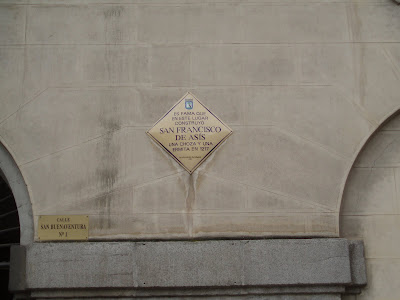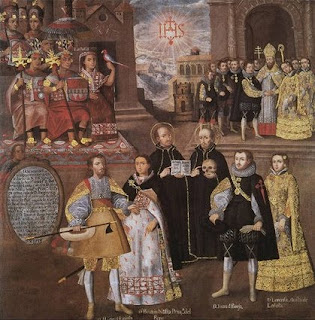
Match all sources consulted by me in pointing out the supreme quality of this work of Baroque Madrid, thus, for example, Don Elias Tormo, the great scholar of ancient churches in Madrid, says it is "the most typical Church of Madrid, and most simply beautiful of the reign of Philip IV , for its architecture and decoration " 1 , my recommendation is to enough to actively seek the visit of this "hidden treasure ."
Such was my intention in this January morning in the rain, not cold, we have been granted a respite to those who, in any season, usually swarm the streets and squares in Madrid, but there you have to reach Plaza de San Francisco and watching the open doorway of the neoclassical gallery leading to the temple, across the street from San Buenaventura, a friendly doorman tells me that the chapel is closed to the public for restoration expected to be completed soon.
I must be patient and wait for my chance, which is also the followers and readers of this blog. However, I think interesting, while the time comes to see the renovated interior, with its famous canopy and the famous cycle of paintings of John Martin Cabezalero passion, knowing, at least, what is the history of this chapel and photograph their abroad. So we, then, of the work done.
History
The Venerable Third Order of Penance, also called, was created by San Francisco by the year 1221 " to extend between the secular life of prayer and penance and with more demands to follow the precepts of the Gospel , not only in his private life but also in its relations with society, to be among its rules to aid the poor and the sick " 2. Formerly "il poverello" had founded the Order of Friars Minor (Franciscans) in 1209 and a second Order of the Poor Sisters (Clare) in 1212, so that the penance was the third Order which he founded to accommodate those Secular Franciscans (tertiary) wishing to pursue a life devoted. In Madrid this Order was established since ancient times and was very popular figure in her characters as important as Lope de Vega, Calderón de la Barca and Francisco de Quevedo.
had this Venerable Third Order (hereinafter designated by its Acronyms VOT) a chapel in the medieval church of San Francisco, next to the Lujanes, but as I wanted to prove to little brothers brothers have a free but without losing the connection to the Franciscan convent. Thus, in 1617, bought a friars' the local Franciscan Commissariat de Indias " 3 rounded this property with other acquisitions in 1638 and 1651. Thus, in 1662, could begin construction of the "hood" whose data on construction costs involved and teachers are well documented and kept on file .
The chapel was designed by Jesuit Brother Bautista Murcia (1594-1679), the architect and author of the monumental work of the Church of Imperial College (now the Collegiate Church of San Isidro). Tormo the judges' most personal creation " 4 . In his designs took another great architect, Sebastian Herrera Barnuevo. The building was constructed "by the master builder Mark Smith" 5 , with the cooperation, imposed by the Order, Luis Román and Juan Delgado and under the supervision and monitoring of the Baptist brother. A López Marcos succeeded in implementing Mateo López " perhaps his son" 6. The opening of the chapel took place in 1668.
From 1760 to 1784, while building the new basilica of San Francisco el Grande served as a church for the Franciscans. In 1888 he was about to be demolished, saving "by the hair." Left untouched by the fires and looting in 1936, but not acted liturgical reform of Vatican II. Says Maria Elena Gomez Moreno 7 in 1968, the VOT undertook a reform unreasonable " adapt to modern demands litíurgicas." Baroque decoration disappeared with the canvas, images, altarpieces and canopy, and even changed the orientation of the altar. The reform was carried out quietly, but their complaint prompted a bitter debate in the newspaper "Madrid" with the community of San Francisco. The direction of Fine Arts stepped in and sanctioned the VOT, ordering restore the chapel to its former self, because, when it was declared a National Monument in 1969 (the previous report is Chueca Goitia), came under direct state intervention .
From 1975 to 1992 in two stages, were carried out repairs to the chapel by the architect of Fine Arts, Maria Angeles Hernández Rubio Muñoyerro, to leave everything as it was after " unfortunate interpretation of the liturgical reform " restoration within the limits of possibility, it seems that the altars were lost to Churrigueresque two years have left them in the open with what is not served "or for chips " 8.
In 2001, the chapel was designated as a Site of Cultural Interest by the Community of Madrid .
now appears that new works are under restoration for more than year and a half, but we could not obtain other information about who does the work, with that budget and completion date as possible.
We have to be content with watching the outside as it is, as shown in photos, of great sobriety. Is a simple brick wall at the bottom has three arches and the top three windows and a simple gable top it off with another window somewhat larger. Behind is seen the spire of the dome, whose skirts are interrupted by dormers, surmounted by ball and cross.


Since we've been a bit "squashed" by the failure to meet this objective, I decided to take advantage of lost time and visit the Art Gallery of San Francisco el Grande, was something that had been pending since my earlier study of this temple, which interested readers can found in another of my blogs 9.
Pinacoteca
The Pinacoteca "Franciscan" as referred to as the P. Esteban Ibañez 10 and is located in the four sections of corridors and rooms located behind the chapel, which is accessed after purchasing the ticket (3 € or 2 €, if you are retired). The visit is fast and explanations, by the uniformed guide, concise.
The gallery is composed of 51 paintings on display and many of them crowded, so I can see, in rather good condition. In the first two sections, we went through really fast, there are works of ancient painters "little known" as our guide, on the Life of San Francisco and other Franciscan saints. These authors "little known" are called José Camarón (1731-1803), Antonio Carnicero (1748-1814), court painter of King Charles IV, Manuel de la Cruz (1750-1792), Zacarias Gonzalez Velazquez (1763-1834 ), Matthew Silvela .... According to Rial 11 Candido, author of the guide which can be purchased at the entrance, there are also works Ribalta, Artemisia Gentileschi, Vincent Carducho, Luis Tristan, and other attributed to Van Loo, and Sanchez Coello, but anyone discovers At this rate .

San Francisco preaching to birds, Butcher
We, the sacristy, a square room that has a Baroque choir stalls, carved by José de la Torre (1702). The frescoes of the vault are Marcelo Jose Contreras and represent the "triumph of the Church." Mirrors are Elizabethan.

The triumph of the Church, Contreras
I just came to take these notes when we are in the sacristy, a rectangular room larger than the previous. The chairs come from the Baroque Monastery of the Paular, brought when the seizure and is complete with drawers and backs, stucco, wood imitation, more modern building. On the walls there is a " Apostolate" , poor replicas of the Bank. On the roof, the "Assumption of Mary " of Contreras and the exterme's stay on the doors, "San Francisco prayer", also from Contreras and " El Divino Pastor and San Francisco " by Francisco Amérigo. The table, " of rosewood and walnut marble top "As commends our guide, was given by Sagasta, to mark the marriage of a daughter. In a niche above the door pricipalmente is a bronze replica of San Francisco de Pedro de Mena, the Cathedral of Toledo.
 vestry
vestry

San Francisco and the Divine Shepherd, Francisco Amérigo
We left the final stages of hall where the "six masterpieces" as our guide, the only ones worth an identification: the " Assumption", attributed to Rizzi, "San Antonio de Padua " Alonso Cano "San Bernardo blessing the bread of the poor" , Francisco Pacheco, Velazquez's father in law, " San Buenaventura visited by St. Thomas Aquinas ", Zurbarán," not the best of them ", dixit guide, and" Maternity Glorification of Mary " by Luca Giordano. The chairs that in the socket is the former who was in the choir, before placement in this place of the "stolen" the monastery of El Parral .

San Bernardo blessing the bread of the poor, F. Pacheco
We went to the roundabout and the visit continues, but I uncheck the group, hoping to return one day more slowly and, if possible, without the accompaniment of a guide .
© Manuel Martínez Bargueño
January, 2011
Difunde entre tus amistades este blog.
NOTAS
1. Elias Tormo “ Las iglesias de Mad rid” . Reedición de los fascículos publicados en 1927. Insituto de España, 1972, p.58.
2 . Áurea de la Morena. “ San Francisco el Grande" . Madrid 12. Espasa-Calpe S. A., 1978.
3 . Tormo, op.cit p. 58.
4. Tormo, op.cit. p.58.
5. Tormo op.cit. p.58.
6. Tormo op.cit. p.59.
7. Tormo, op.cit p. 61, note written by María Elena Gómez Moreno.
8. ABC, 26.11.1980.
9. Http://manuelblasmartinezmapes.blogspot.com/ (Search in "San Francisco El Grande").
10. P. Esteban Ibañez. " San Francisco el Grande in history and art ." Editorial offo. Madrid, 1962, p.93.
11. " San Francisco el Grande. Description historical and artistic ", 5 th edition. Madrid, 2003.










































